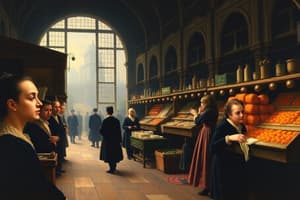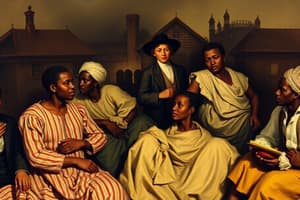Podcast
Questions and Answers
What was a common occupation of abolitionists in the village of Lynn?
What was a common occupation of abolitionists in the village of Lynn?
- Shoemakers (correct)
- Merchants
- Farmers
- Bakers
What was the main purpose of the antislavery fairs organized by the abolitionists?
What was the main purpose of the antislavery fairs organized by the abolitionists?
- To raise awareness about the abolitionist movement
- To promote women's rights
- To boycott consumer products
- To raise funds for the abolitionist movement (correct)
Why did the abolitionists organize boycotts of consumer products like sugar?
Why did the abolitionists organize boycotts of consumer products like sugar?
- Because sugar was unhealthy
- Because sugar came from slave labor (correct)
- Because sugar was scarce
- Because sugar was too expensive
What social class did the Female Anti-Slavery Society in Boston primarily consist of?
What social class did the Female Anti-Slavery Society in Boston primarily consist of?
What was one way the antislavery movement allowed individuals to participate in?
What was one way the antislavery movement allowed individuals to participate in?
Flashcards are hidden until you start studying
Study Notes
The Female Anti-Slavery Society
- Consisted of women from diverse backgrounds, including those whose husbands worked in industries such as coal, tailoring, and baking, as well as women from wealthy families, in Boston.
Abolitionists in Lynn
- Many abolitionists in Lynn were shoemakers by occupation.
- Organized boycotts of consumer products that came from slave labor, specifically sugar.
- Sold handmade goods at antislavery fundraising fairs.
- Participated in the antislavery movement as a way to engage in "respectable" middle-class culture.
- Provided an opportunity for both men and women to have a say in American life.
Studying That Suits You
Use AI to generate personalized quizzes and flashcards to suit your learning preferences.




